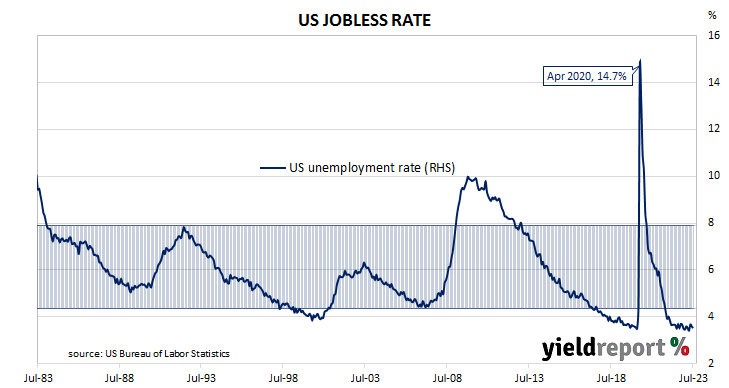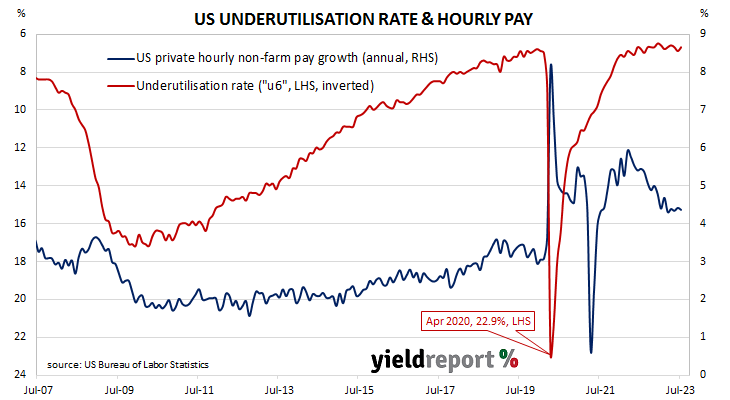Summary: Non-farm payrolls up 187,000 in July, in line with expectations; previous two months’ figures revised down by 49,000; jobless rate ticks down to 3.5%, participation rate steady; ANZ: private payrolls growth has clear downward trend; employed-to-population ratio ticks up to 60.4%; underutilisation rate down; annual hourly pay growth steady at 4.4%.
The US economy ceased producing jobs in net terms as infection controls began to be implemented in March 2020. The unemployment rate had been around 3.5% but that changed as job losses began to surge through March and April of 2020. The May 2020 non-farm employment report represented a turning point and subsequent months provided substantial employment gains which continued through into 2021 and 2022. Changes in recent months have been generally more in line with the average of the last decade.
According to the US Bureau of Labor Statistics, the US economy created an additional 187,000 jobs in the non-farm sector in July. The increase was essentially in line with the 190,000 which had been generally expected and the 185,000 jobs which had been added in June after revisions. Employment figures for May and June were revised down by a total of 49,000.
The total number of unemployed decreased by 116,000 to 5.841 million while the total number of people who were either employed or looking for work increased by 152,000 to 167.103 million. These changes led to the US unemployment rate ticking down from June’s figure of 3.6% to 3.5% as the participation rate remained steady at 62.6%.
“Private payrolls growth has a clear downward trend, particularly in leisure/hospitality, manufacturing and temporary hiring,” said ANZ senior economist Adelaide Timbrell.
Shorter-term US Treasury yields fell noticeably on the day. By the close of business, the 2-year yield had shed 10bps to 4.78%, the 10-year yield had lost 14bps to 4.04% while the 30-year yield finished 10bps lower at 4.20%.
In terms of US Fed policy, expectations of a lower federal funds rate in the first half of 2024 hardened. At the close of business, contracts implied the effective federal funds rate would average 5.34% in September, slightly above the current spot rate, and then increase to an average of 5.36% in October. December futures contracts implied a 5.385% average effective federal funds rate while August 2024 contracts implied 4.585%, 74bps less than the current rate.
One figure which is indicative of the “spare capacity” of the US employment market is the employment-to-population ratio. This ratio is simply the number of people in work divided by the total US population. It hit a cyclical-low of 58.2 in October 2010 before slowly recovering to just above 61% in late-2019. July’s reading ticked up to 60.4%, still some way from the April 2000 peak reading of 64.7%.
Apart from the unemployment rate, another measure of tightness in the labour market is the underutilisation rate and the latest reading of it registered 6.7%, down from 6.9% in June. Wage inflation and the underutilisation rate usually have an inverse relationship and hourly pay growth in the year to July remained steady revisions at 4.4%.



